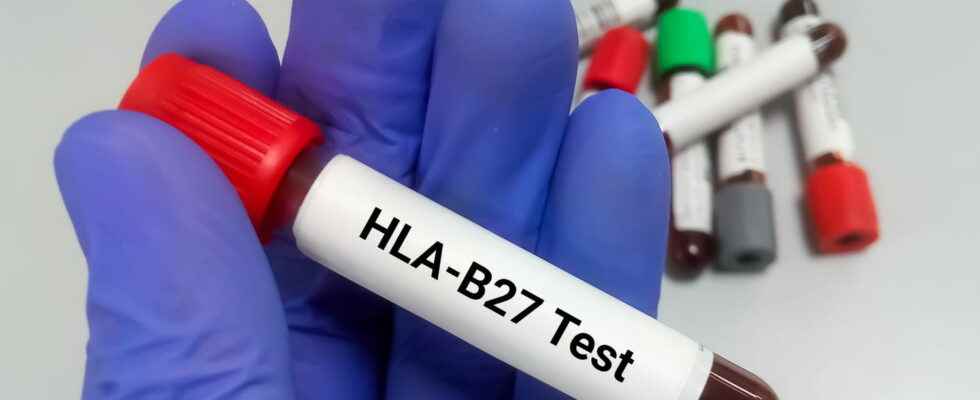8% of the French population carries the HLA B27 antigen. Its presence is associated with a number of rheumatic diseases, such as ankylosing spondyloarthritis.
Definition: what is the HLA-B27 antigen?
8% of the French population carries the HLA B27 antigen and will be asymptomatic. The human leukocyte antigens (HLA) are proteins that help the immune system of the body to distinguish between its own cells and foreign and harmful substances. “The HLA-B27 protein, located on the surface of white blood cells, has been linked to development of spondyloarthritis, a group of inflammatory diseases including ankylosing spondyloarthritis“, explains Dr. Pascal Chazerain, rheumatologist.
When are we looking for it?
“The search for the HLA-B27 antigen can be requested when the patient has acute or chronic pain and inflammation of the spine, neck, chest, eyes and/or jointsand if the doctor suspects that the cause is a disease of the spondyloarthritis group“, details Dr. Chazerain. “The result of this search does not constitute a diagnosis, but adds information, increasing or decreasing the probability that the patient has the disease“, says Professor Francis Berenbaum, rheumatologist.
The HLA-B27 antigen is detected in a simple blood test.
What diseases can it be associated with?
“The presence of the HLA-B27 antigen is associated with the development of spondyloarthritis, a group of inflammatory diseases that usually affect the skeleton and include, among others, ankylosing spondyloarthritis (AS)“, answers details Dr. Chazerain.
In addition, “the presence of the HLA-B27 antigen is associated with the development of other pathologies, mainly reactive arthritis, psoriatic arthritis and inflammatory enterocolopathy rheumatism (Crohn’s disease and ulcerative colitis)“, adds Professor Berenbaum.
What is the risk of ankylosing spondyloarthritis?
“There is a strong association between HLA-B27 antigen and the risk of having spondyloarthritisconfirms Professor Berenbaum. About 60% of people with ankylosing spondyloarthritis have a positive HLA B27“. According to’Insermthe role of the HLA-B27 antigen was described in the 1970s. This molecule is found in 60-90% of people with spondyloarthritis. However, not very specific for the disease, it is also found in 7% of healthy subjects in the general population. If nearly half of the genetic predisposition to spondyloarthritis seems attributable to the HLA-B27 antigen, there is other transmissible factors explaining the heritability of the disease.
What is the risk of psoriatic arthritis?
“People who carry the HLA-B27 antigen in their chromosomes have a higher risk of developing psoriatic arthritis“, answers Dr. Chazerain. This gene is present in 20-30% of people with psoriatic arthritis.
What is the risk of acute anterior uveitis?
“Acute anterior uveitis (a red and painful eye for more than 48 hours) can be associated with all forms of spondyloarthritis, especially in the presence of the HLA-B27 antigen“, observes the Professor.
Transmission: is the HLA-B27 antigen hereditary?
“If you do not have the HLA-B27 antigen (neither you nor your spouse), the risk of transmitting the disease is very low.acknowledges Dr. Chazerain. If one of the parents is a B27 carrier, the children will have a one in two risk of inheriting the antigen, but not necessarily disease”.
8% of the French population carries the HLA B27 antigen and will be asymptomatic
What to do if you are a carrier of the HLA-B27 antigen?
“If a person is a carrier of the HLA-B27 antigen associated with chronic spinal pain, usually nocturnal, inflammation and/or suggestive abnormalities on radiological examinations, his disease is then compatible with the diagnosis of spondyloarthritise“, emphasizes Dr. Chazerain. This is especially true if the patient is a young man, and if he has his first symptoms before the age of 40. A person carrying the HLA-B27 antigen will not necessarily develop one of these diseases. 8% of the French population carries the HLA B27 antigen and will be asymptomatic.
Thanks to Professor Francis Berenbaum, rheumatologist at Saint-Antoine Hospital and head of the Inserm team “Articular pathologies associated with metabolic diseases and age” and to Dr Pascal Chazerain, head of the rheumatology department of the Diaconesses Croix hospital group Saint Simon (Paris) for their validation.
